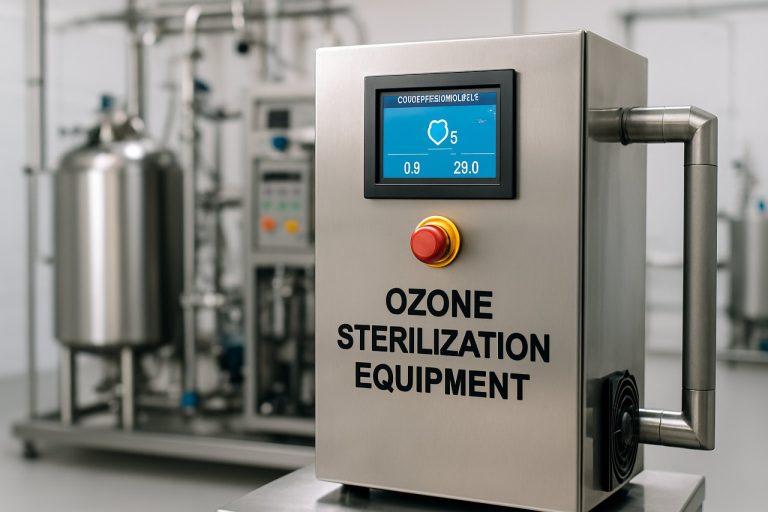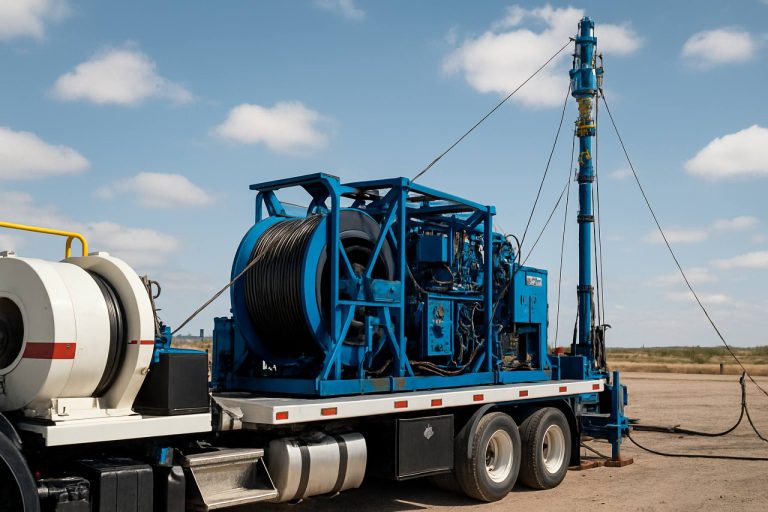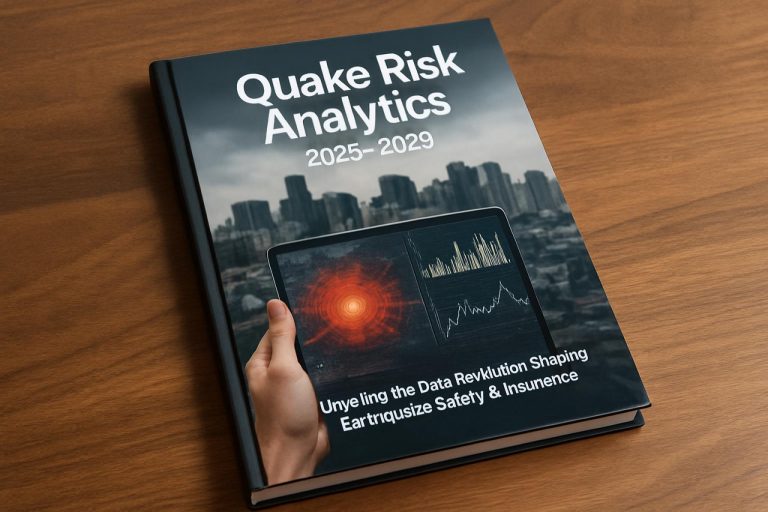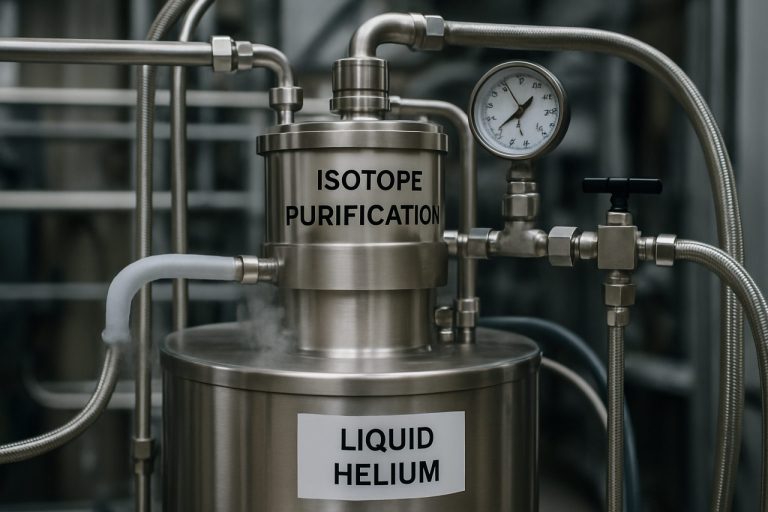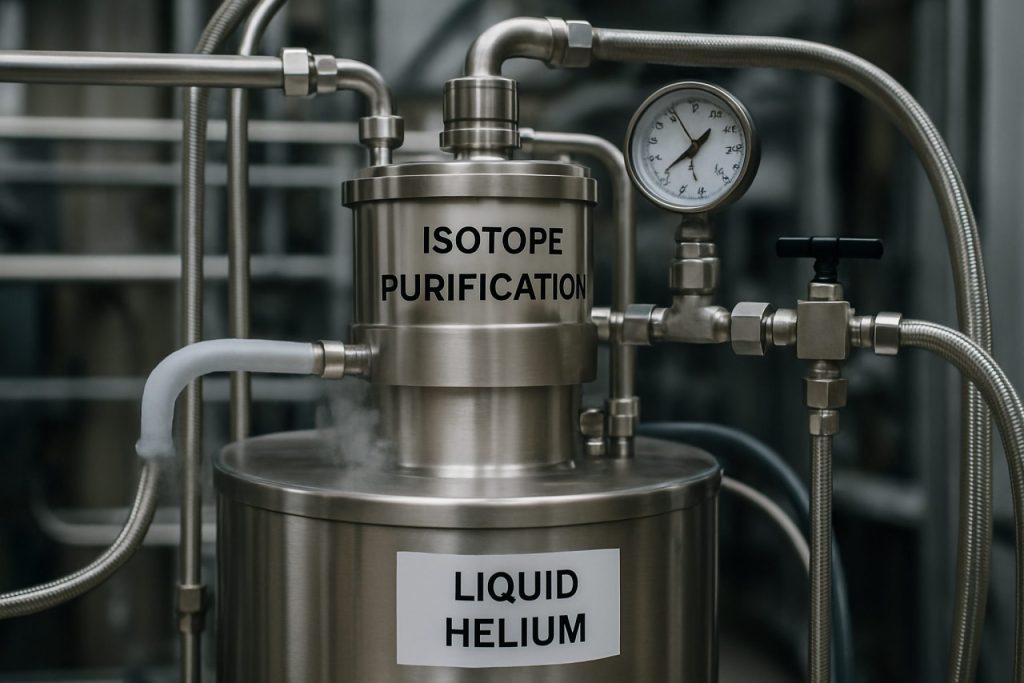
Table of Contents
- Executive Summary: 2025 Industry Snapshot
- Global Demand Drivers for Liquid Helium Isotope Purification
- Emerging Purification Technologies and System Innovations
- Key Players & Leading Manufacturers (e.g., quantumdesign.com, cryomech.com, linde.com)
- Regulatory and Safety Standards: Compliance Trends
- Market Forecasts 2025–2030: Volume, Value, and Regional Analysis
- Applications in Quantum Computing, Medical Imaging, and Space Exploration
- Supply Chain Challenges and Opportunities
- Sustainability Initiatives and Helium Recycling
- Future Outlook: Next-Gen Purification, Investment Hotspots, and Disruptive Trends
- Sources & References
Executive Summary: 2025 Industry Snapshot
In 2025, the global market for liquid helium isotope purification systems is characterized by a surge in demand driven by quantum technologies, advanced research, and semiconductor applications. The purification of helium isotopes—primarily 3He and 4He—is crucial for achieving the ultra-high purity levels required in cryogenics, low-temperature physics, and precision instrumentation. Current purification systems leverage cryogenic distillation, membrane separation, and advanced getter technologies to achieve isotopic purities exceeding 99.99%.
Key industry participants such as Linde plc and Air Liquide continue to invest in scaling up purification infrastructure, responding to the increasing need for isotopically pure helium in quantum computing and superconducting applications. For instance, Linde plc has expanded its helium refining capacity in the United States and Asia to address anticipated supply chain constraints and the rising cost of raw helium feedstock.
The market is also witnessing innovation in compact, modular purification equipment, allowing research institutions and specialty gas suppliers to operate decentralized purification units. Companies like Quantum Design are developing system solutions that integrate seamlessly with dilution refrigerators and other low-temperature research equipment, streamlining the supply of high-purity helium isotopes for end-users.
Supply chain resilience remains a strategic focus, particularly in light of recent geopolitical and logistical disruptions. Industry leaders are diversifying sourcing and investing in recycling and recovery systems to minimize losses of rare 3He. Additionally, collaboration between government agencies and private sector stakeholders, such as those fostered by the Brookhaven National Laboratory, are expected to enhance domestic isotope purification and storage capabilities.
Looking ahead, the outlook for 2025 and beyond points to continued growth, with emphasis on sustainability and cost optimization. Advances in purification efficiency and automation are expected to reduce operational costs and environmental impact. Strategic partnerships and targeted investments in R&D will likely shape the competitive landscape, as suppliers strive to meet the stringent purity requirements of next-generation quantum devices and medical imaging technologies.
Global Demand Drivers for Liquid Helium Isotope Purification
The global demand for liquid helium isotope purification systems is expected to rise steadily through 2025 and beyond, driven by a convergence of technological, scientific, and industrial factors. Helium-3 and helium-4 isotopes, purified to ultra-high levels, are indispensable in a range of advanced applications, particularly as quantum computing, cryogenics, and medical imaging technologies mature and scale.
Quantum computing is a critical driver, with research centers and commercial ventures worldwide requiring ultra-pure helium-3 for dilution refrigerators, which are essential for achieving millikelvin temperatures. The rapid proliferation of quantum research hubs in North America, Europe, and Asia is translating into increased demand for purification systems capable of delivering isotopic purities exceeding 99.999%. Companies such as Oxford Instruments and Bluefors Oy are expanding their cryogenic systems offerings, emphasizing helium isotope management and purification as core value propositions.
In the medical sector, helium-3 is vital for magnetic resonance imaging (MRI) of lungs, offering non-invasive diagnostics for pulmonary diseases. The growing adoption of such advanced imaging modalities in developed healthcare systems is expected to fuel further demand for reliable isotope purification. Institutions like Linde plc play a crucial role in the supply chain, providing purified helium isotopes for medical and scientific use.
Fusion energy research is another significant demand driver. Helium-3, with its potential as a fuel in aneutronic fusion reactors, is attracting renewed interest. As international fusion projects such as ITER progress, the need for high-purity isotopes for experimentation and prototype reactors is likely to increase. Air Liquide and Advanced Specialty Gases are enhancing their gas purification capabilities to support such large-scale scientific initiatives.
In the next few years, global supply chains are expected to remain tight, as helium isotope production is inherently limited and subject to geopolitical constraints. This scenario underlines the strategic importance of advanced purification systems capable of recycling and upgrading existing helium stocks. Leading suppliers are investing in new purification technologies to improve efficiency and scalability, anticipating continued strong demand through 2025 and the near future.
Emerging Purification Technologies and System Innovations
The field of liquid helium isotope purification is witnessing notable advances as the demand for both helium-3 and helium-4 isotopes intensifies across quantum computing, medical imaging, and fusion research sectors. Current and emerging purification technologies are focused on achieving higher isotope separation efficiencies, minimizing losses, and reducing operational costs.
In 2025, a key trend is the deployment of advanced cryogenic distillation systems, which leverage ultra-low temperature gradients and precise pressure controls to separate helium-3 from helium-4 at industrial scales. Linde plc and Air Liquide have both invested in next-generation distillation columns that maximize throughput while improving isotope purity to above 99.99%, a level required for sensitive applications in neutron detection and low-temperature physics. These innovations often integrate automated process controls and real-time impurity monitoring, enabling rapid adjustments to process parameters and reducing human intervention.
Recent prototypes from Cryomech Inc. combine pulse-tube refrigeration with multi-stage heat exchangers, allowing for continuous operation and improved energy efficiency. This approach is particularly attractive for research institutions needing reliable, on-demand supplies of purified helium-3 for dilution refrigerators used in quantum computing platforms.
Another promising direction is the utilization of membrane-based gas separation technologies. Efforts led by IBM Research and partners in national laboratories are exploring nanoporous membranes capable of selectively filtering helium isotopes based on subtle differences in atomic behavior at cryogenic temperatures. While still largely experimental in 2025, early data suggest that these membrane systems could supplement traditional cryogenic distillation, offering modular and potentially lower-cost solutions for smaller-scale isotope recovery and recycling.
Looking ahead, the next few years are expected to bring further integration of digital twins and predictive maintenance in purification system operations, as seen in pilot programs at Linde plc. These digital tools optimize scheduling and detect contamination risks before they impact isotope purity, supporting both operational efficiency and product quality.
With global helium supply chains under pressure, the ongoing innovation in purification systems is critical for ensuring steady and affordable access to helium isotopes. The sector is poised for continued growth as new technologies mature and are adopted by both commercial suppliers and scientific end-users.
Key Players & Leading Manufacturers (e.g., quantumdesign.com, cryomech.com, linde.com)
The global landscape for liquid helium isotope purification systems in 2025 is marked by the presence of several key manufacturers and technology providers, each contributing distinct advancements to the field. These systems are crucial for delivering high-purity helium-3 and helium-4, both of which are essential for applications ranging from low-temperature physics research to quantum computing and advanced medical imaging.
One of the most prominent companies in this domain is Quantum Design, which continues to offer advanced cryogenic and helium management solutions. Their systems are widely adopted in research institutions and national laboratories, particularly for the purification and recovery of helium isotopes used in dilution refrigerators and superconducting magnet systems.
Another significant player is Cryomech, Inc., recognized for its innovative cryocoolers and helium liquefiers. In recent years, Cryomech has expanded its portfolio to include integrated purification modules capable of delivering research-grade helium-4 and helium-3. Their modular approach allows for seamless integration with existing laboratory infrastructure, an important feature as the scientific community seeks to optimize helium use and reduce operational costs.
Linde plc stands out as a global industrial gas and engineering company with a dedicated focus on helium recovery and purification technology. Linde’s state-of-the-art systems provide scalable purification capacity, addressing both large-scale industrial needs and specialized research demands. Their portfolio now features advanced isotope separation technologies, which are becoming increasingly relevant due to the rising scarcity and cost of helium-3.
Additionally, Oxford Instruments remains a key supplier of cryogenic systems, including helium isotope handling and purification equipment. Their solutions are widely used in quantum research and low-temperature physics, supporting the efficient recycling and purification of helium isotopes to meet stringent application standards.
Looking forward, the next few years are expected to see further collaboration among these manufacturers and leading research institutions, aimed at enhancing the efficiency and automation of helium isotope purification. With helium-3 in especially short supply, the industry is prioritizing closed-loop systems and advanced membrane separation technologies, ensuring sustainable access to high-purity isotopes for scientific and industrial innovation.
Regulatory and Safety Standards: Compliance Trends
The regulatory and safety landscape for liquid helium isotope purification systems is evolving rapidly as global demand for high-purity helium-3 and helium-4 increases, especially in quantum computing, cryogenics, and nuclear fusion research. As of 2025, compliance trends are shaped by stricter controls on handling, storage, and transportation of cryogenic gases, and by the increasing need for traceability and quality assurance in isotope purity.
In the United States, the Compressed Gas Association (CGA) continues to update its standards for cryogenic liquids, including helium, focusing on safe storage vessel design, labelling, and operational protocols. These standards are widely adopted by major purification system manufacturers to ensure regulatory compliance. The American Society of Mechanical Engineers (ASME) also maintains the Boiler and Pressure Vessel Code, which sets essential requirements for the pressure vessels integral to helium purification systems, with periodic updates reflecting advances in materials and safety checks.
Globally, companies such as Linde and Air Liquide have implemented internal compliance frameworks that often exceed minimum legal requirements. They prioritize risk assessments, emergency response training, and adherence to international standards like ISO 21010 (Cryogenic Vessels) and ISO 9001 (Quality Management Systems). Operators must maintain detailed records on isotope purity and system performance for audits by regulatory bodies and customers in sensitive sectors.
In the European Union, the European Chemicals Agency (ECHA) oversees the classification and safe use of helium isotopes under REACH regulations, with recent guidance emphasizing safe handling and environmental protection during purification and transport. As helium-3 is a controlled substance in several jurisdictions due to its applications in nuclear technologies, additional licensing and end-user verification are required, particularly for export outside the EU.
Looking ahead to the next few years, digitalization of compliance—through automated monitoring, IoT-enabled safety systems, and blockchain-based traceability—is expected to become standard among leading suppliers. This trend aims to reduce human error, streamline audits, and offer real-time purity validation, as seen in pilot programs by Praxair (now part of Linde). As quantum computing and fusion energy sectors expand, further harmonization of safety and quality standards across regions will likely follow, driving increased transparency and higher baseline requirements for all liquid helium isotope purification system stakeholders.
Market Forecasts 2025–2030: Volume, Value, and Regional Analysis
The global market for liquid helium isotope purification systems is projected to experience notable growth between 2025 and 2030, driven by increasing demand for high-purity helium-3 (He-3) and helium-4 (He-4) isotopes in quantum computing, medical imaging, and fundamental research applications. Supply chain constraints, particularly regarding He-3—an isotope with limited natural abundance—are prompting investments in advanced purification technologies and infrastructure upgrades.
In terms of market volume, the annual throughput of purified helium isotopes is expected to increase by approximately 8–12% per year between 2025 and 2030, with North America, Europe, and East Asia accounting for the majority of production and consumption. The United States continues to play a pivotal role due to its legacy helium reserves and active purification facilities managed by organizations such as the Bureau of Land Management and private entities like Air Products and Chemicals, Inc.. In Europe, companies such as Linde plc and Air Liquide S.A. are investing in next-generation isotope separation units to serve the region’s growing research and healthcare markets.
The market value for liquid helium isotope purification systems is estimated to reach USD 650–700 million by 2030, up from an estimated USD 400 million in 2025. This growth is underpinned by an escalating need for ultra-high-purity helium in superconducting magnets, cryogenics, and national security applications. Regional analysis suggests that Asia-Pacific, led by China and Japan, will register the fastest growth, supported by government-backed quantum technology initiatives and the expansion of domestic research infrastructure. Chinese suppliers such as Suoyuan Cryogenic Equipment Co., Ltd. are increasing their footprint in both domestic and export markets, focusing on modular and energy-efficient purification solutions.
- North America: Maintains the largest installed base and leads in R&D investment for isotope purification, with expansion projects planned by Air Products and Chemicals, Inc. and public laboratories.
- Europe: Expected to witness steady growth as Linde plc and Air Liquide S.A. scale up purification capacity and enhance supply chain reliability.
- Asia-Pacific: Poised for double-digit market growth, with China focusing on securing domestic supply and technological capabilities through firms like Suoyuan Cryogenic Equipment Co., Ltd..
Looking ahead, the market outlook from 2025 to 2030 is characterized by strong capital investment in new purification plants, advances in membrane and cryogenic distillation technologies, and strategic collaborations between industry and research institutions, all aimed at ensuring reliable, high-volume supply of purified helium isotopes for emerging applications.
Applications in Quantum Computing, Medical Imaging, and Space Exploration
Liquid helium isotope purification systems are increasingly vital in cutting-edge sectors such as quantum computing, medical imaging, and space exploration. The year 2025 and the immediate future are witnessing a growing demand for ultra-pure helium-3 and helium-4 isotopes, each with distinct roles in these advanced applications.
In quantum computing, the need for highly purified helium-3 and helium-4 is accelerating. Quantum computers often operate at millikelvin temperatures, achievable only with dilution refrigerators that depend on isotopically pure helium-3/helium-4 mixtures. The expanding development of superconducting qubits and spin-based quantum devices drives demand for reliable purification technology. Companies such as LeJacq and Oxford Instruments are developing and supplying isotope purification and dilution refrigeration systems tailored for quantum research, with continual advances focused on higher purity and reliability for next-generation quantum hardware.
In medical imaging, especially in the field of magnetic resonance imaging (MRI) and hyperpolarized gas imaging, helium-3 is used as a contrast agent for lung imaging. However, the global helium-3 supply remains limited, amplifying the importance of efficient purification and recovery systems. Air Liquide and Cryomech provide cryogenic technology and purification solutions that help maximize helium isotope recovery and purity for medical-grade applications, supporting clinical research and the potential expansion of hyperpolarized imaging in respiratory diagnostics.
Space exploration missions, particularly those involving particle detectors, cryogenic sensors, or cosmic microwave background (CMB) research, require ultra-pure helium isotopes both for cooling and as detector media. The European Space Agency and NASA missions, as well as national laboratories, increasingly rely on suppliers such as Linde for helium purification and liquefaction technology. These systems ensure the purity levels necessary for sensitive scientific instrumentation deployed in space or at remote observatories.
Looking ahead, the outlook for liquid helium isotope purification systems is tied to the rapid expansion of quantum computing and the continuing innovation in medical and space technologies. As R&D programs scale up and the need for rare isotopes grows, manufacturers are expected to invest in higher-capacity, energy-efficient purification platforms and closed-loop recovery systems. Companies with proven expertise in cryogenics and purification, such as Oxford Instruments and Cryomech, are likely to expand their portfolios to meet these stringent demands, supporting scientific breakthroughs across multiple sectors by 2030.
Supply Chain Challenges and Opportunities
The global supply chain for liquid helium isotope purification systems is undergoing significant transformation as demand accelerates across quantum computing, fusion research, and medical imaging sectors. In 2025, supply chain challenges are shaped by geopolitical uncertainties, limited feedstock sources, and the technical complexity of purification. However, these challenges also present opportunities for innovation, collaboration, and strategic investment.
A key bottleneck remains the scarcity of raw helium-3 and helium-4 feedstock. Helium-3, in particular, is primarily sourced as a byproduct of tritium decay from nuclear weapons programs, resulting in highly limited and politically sensitive supply channels. Major producers, such as Orano and Air Liquide, continue to invest in advanced isotope separation and purification technologies, but scaling commercial output to meet research and industrial needs remains challenging.
Logistics and transportation also present ongoing risks. Liquid helium is cryogenic and requires specialized containers and supply chain infrastructure. Disruptions in global shipping or regional conflicts can delay deliveries, impacting critical projects in quantum technology and national laboratories. In response, suppliers such as Linde are expanding decentralized production and storage capabilities, aiming to buffer regional markets from global shocks.
At the same time, opportunities are emerging. Several suppliers are forming strategic alliances to secure feedstock and share purification infrastructure. For example, Air Products is collaborating with research institutions to develop next-generation membrane and cryogenic distillation systems, targeting greater yield and purity of helium isotopes. These advancements are expected to reduce dependence on legacy sources and lower overall system costs.
Looking ahead to the next few years, the industry anticipates gradual easing of supply constraints as new purification facilities come online and recycling initiatives mature. Investments in automation and digital monitoring are streamlining quality control and logistics, while public-private partnerships are fostering innovation in both extraction and purification methods. Nonetheless, the sector’s exposure to upstream geopolitical and technical risks means that robust contingency planning will remain essential for all participants in the helium isotope supply chain.
Sustainability Initiatives and Helium Recycling
In 2025, sustainability initiatives are increasingly shaping the development and deployment of liquid helium isotope purification systems. As global supplies of helium—particularly the rare isotope helium-3—remain constrained, manufacturers and end-users are prioritizing technologies that maximize reuse and minimize waste. The focus on closed-loop systems and efficient isotope separation is particularly strong among research institutions, medical imaging facilities, and quantum technology labs, where ultra-pure helium-3 and helium-4 are essential but expensive resources.
Leading industry players are advancing helium recovery and recycling solutions. For example, Linde engineers and deploys helium purification and liquefaction systems designed to capture, separate, and recycle helium isotopes from laboratory and industrial exhaust streams. Linde’s platforms enable significant reductions in raw helium consumption, supporting both cost savings and environmental stewardship for customers. Similarly, Praxair (now part of Linde) continues to supply modular helium recovery units that can be integrated with isotope purification skids, targeting high-purity applications such as MRI facilities and low-temperature physics research.
Companies specializing in cryogenic technologies are also expanding their portfolios to address isotope-specific purification. Cryomech and Oxford Instruments offer advanced cryocoolers and liquefiers that interface with purification columns and membrane separators capable of discriminating between helium-3 and helium-4. These solutions are being adopted in laboratories and commercial helium reprocessing plants, supporting circular use models and reducing the environmental impact of helium extraction.
- In 2025, major scientific user facilities, such as neutron research centers and quantum computing hubs, are investing in on-site helium isotope recycling infrastructure. These systems leverage pressure swing adsorption, cryogenic distillation, and gas chromatography to recover and purify isotopes with high efficiency, aligning with sustainability goals and cost containment.
- Industry collaborations are growing, with manufacturers like Air Liquide working alongside universities and research consortia to optimize separation process technologies, aiming to lower the energy intensity and carbon footprint of isotope purification.
Looking ahead, the outlook for liquid helium isotope purification systems remains positive, with ongoing R&D focused on enhancing recovery rates, reducing system complexity, and integrating artificial intelligence for process optimization. Industry and research stakeholders are expected to continue prioritizing sustainable helium management, especially as regulatory scrutiny around resource usage and emissions intensifies over the next several years.
Future Outlook: Next-Gen Purification, Investment Hotspots, and Disruptive Trends
The landscape for liquid helium isotope purification systems is set for significant transformation through 2025 and the years immediately following, driven by technological innovation, strategic investments, and evolving end-user demands. The push for higher purity isotopes—particularly 3He and 4He—remains fundamental for sectors such as quantum computing, fundamental physics, and advanced medical imaging.
Next-generation purification technologies are focusing on both efficiency and scalability. Companies such as Linde and Air Liquide are actively developing advanced cryogenic distillation and membrane separation systems that enhance isotope separation yields while reducing operational costs and environmental footprint. Notably, Cryo Industries of America is exploring modular purification units designed for on-site integration, offering smaller research facilities access to high-purity helium isotopes without reliance on centralized processing plants.
Looking to investment hotspots, major research infrastructure projects—such as those in quantum information science and neutron scattering—are attracting both public and private sector funding. Europe and North America are leading with initiatives like upgrades to the European Spallation Source and U.S. National Quantum Initiative, both requiring sustained supplies of ultra-pure helium isotopes. This is catalyzing direct investment into purification system upgrades and supply chain resilience from suppliers like Praxair (now part of Linde).
- Automated control systems and AI-driven process optimization are emerging as disruptive trends, with companies such as Oxford Instruments developing digital twins and real-time monitoring for purification units to maximize throughput and purity.
- Decentralization is another key trend, with demand shifting toward smaller, adaptable systems that enable local isotope purification, reducing logistics costs and supply risks.
- Collaborative R&D—particularly cross-Atlantic partnerships—is accelerating the translation of academic breakthroughs in isotope separation into commercially viable technologies, as seen in collaborations involving Air Liquide and European research consortia.
In summary, the coming years will see liquid helium isotope purification systems grow smarter, more modular, and closely aligned with the needs of high-tech industries. Companies with the ability to scale up new purification approaches, automate operations, and localize production are likely to capture emerging market opportunities, keeping pace with the rapid expansion of both quantum and fundamental science applications.
Sources & References
- Linde plc
- Air Liquide
- Brookhaven National Laboratory
- Oxford Instruments
- Bluefors Oy
- Advanced Specialty Gases
- Cryomech Inc.
- American Society of Mechanical Engineers
- European Chemicals Agency
- Praxair
- Bureau of Land Management
- LeJacq
- Orano
- Cryo Industries of America
